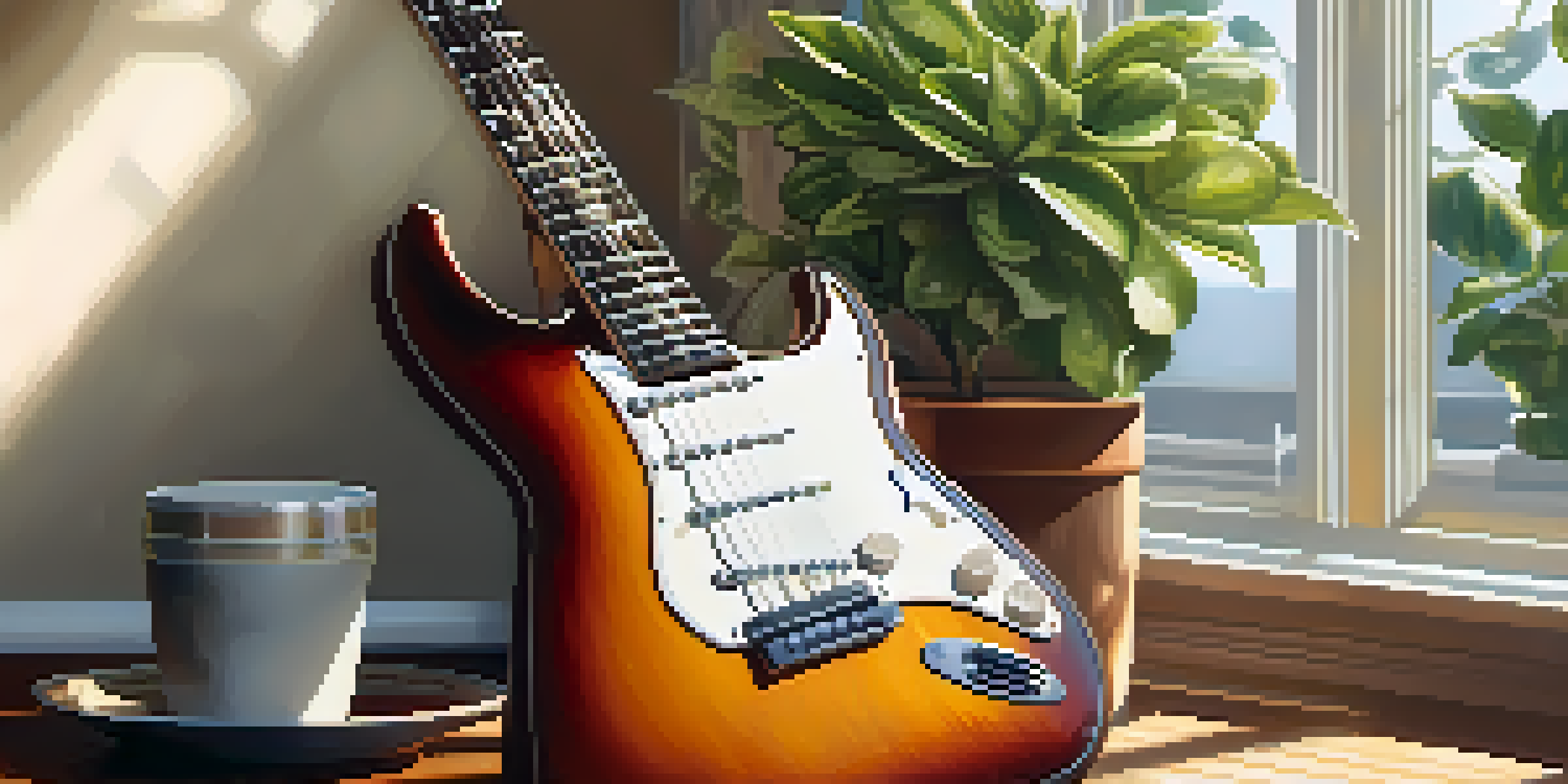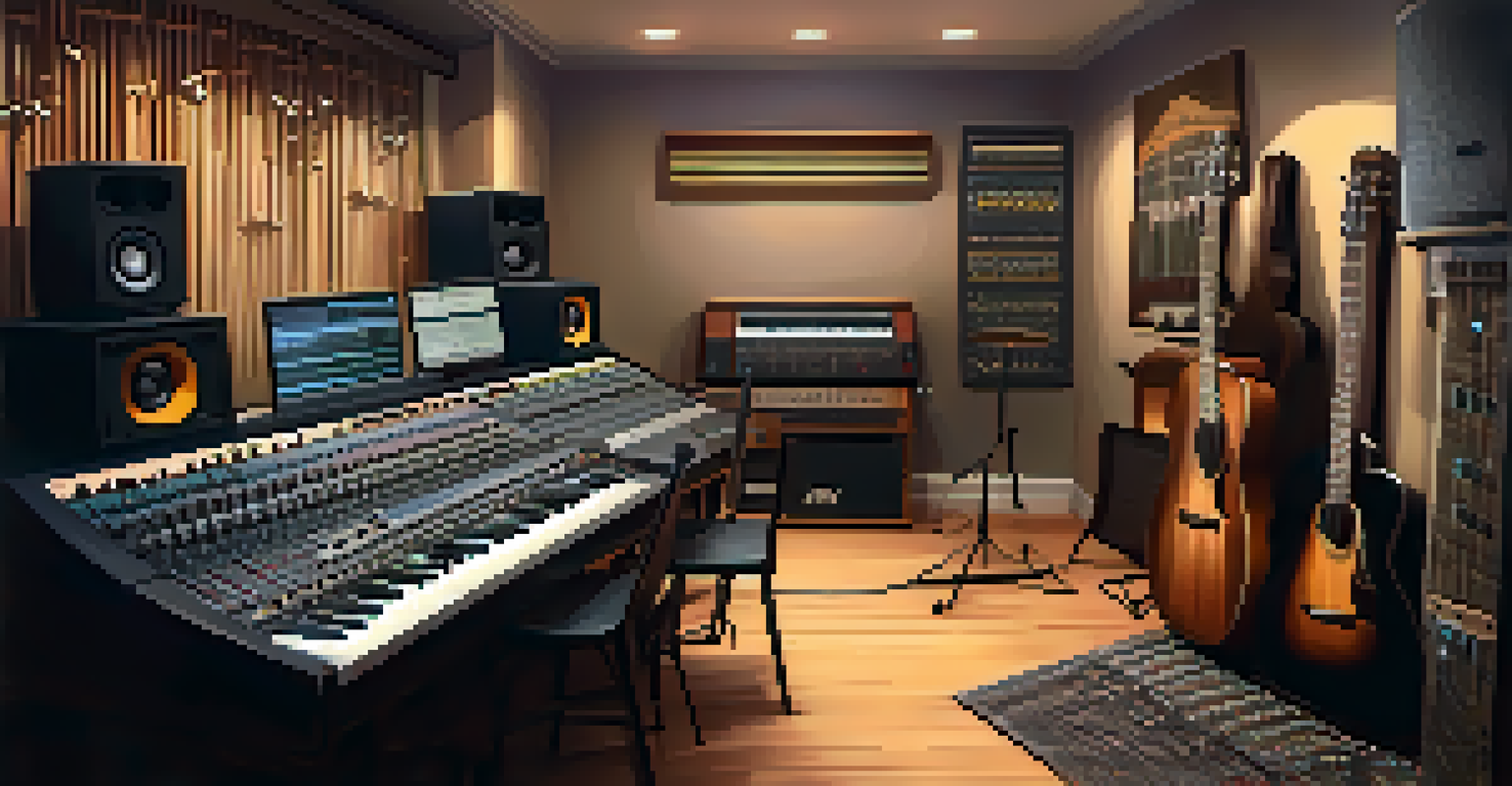Mixing Guitar Tracks: Achieving a Balanced Sound

Understanding the Basics of Mixing Guitar Tracks
Mixing guitar tracks is an essential skill for any musician or producer looking to create a polished sound. At its core, mixing involves adjusting levels, panning, and applying effects to ensure that each track complements the others. Think of it like cooking a meal; each ingredient must be balanced to create a delicious dish. If one flavor overwhelms, the entire experience can be off-putting, just like a guitar track that drowns out the vocals.
The mixing is the art of balancing each part so that it supports the whole.
Before diving into the mix, it's crucial to have a clear understanding of the different components of your guitar tracks. This includes rhythm guitars, lead guitars, and any additional layers that contribute to the overall sound. Each element plays a unique role, much like instruments in an orchestra, and understanding their dynamics will help you create harmony in your mix.
Lastly, don’t forget to trust your ears. While there are guidelines and techniques to follow, the best mixes often come from personal intuition and experience. So, take the time to listen critically and develop your unique mixing style.
Setting the Right Levels for Each Track
One of the first steps in mixing is setting the right levels for each guitar track. Start by adjusting the fader for each track so that they sit well together in the mix. Imagine you're in a band; each member needs to be heard without overpowering the others. If the lead guitar is too loud, for example, it can overshadow the rhythm section, leading to a muddy sound.

A useful technique is to solo each guitar track while adjusting its level, making it easier to hear where it fits in the overall mix. However, remember to bring all tracks back into play to maintain perspective. This way, you can ensure that no single part dominates without context, preserving the integrity of your song.
Master Levels for Balanced Mixing
Setting the right levels for each guitar track ensures that all elements can be heard clearly without overpowering one another.
As you set these levels, keep an eye on your meters to avoid clipping, which can introduce unwanted distortion. Maintaining a healthy balance will set the foundation for a professional-sounding mix.
Using Panning to Create Space in Your Mix
Panning is a powerful tool in mixing that helps create a sense of space and dimension in your guitar tracks. By positioning different guitar parts across the stereo field, you can give each element its own space, much like arranging furniture in a room. This prevents clutter and allows each track to be heard clearly.
Music is the shorthand of emotion.
For instance, you might pan rhythm guitars slightly to one side while placing lead guitars on the opposite side. This creates a stereo image that feels balanced and dynamic, making the mix more engaging to the listener. It’s akin to creating a visual landscape where every element has its own place.
However, be cautious not to overdo it; extreme panning can lead to an unbalanced mix. Aim for a natural feel, where your ears can comfortably engage with all elements without any feeling lost or isolated.
Applying Equalization for Clarity and Definition
Equalization, or EQ, is a crucial step in mixing guitar tracks that can enhance clarity and definition. By adjusting the frequency ranges of your guitar sounds, you can carve out space for each track, ensuring that they don’t interfere with one another. For example, if a rhythm guitar has too much low-end, it can muddy the mix, while a lead guitar might need a boost in the higher frequencies to cut through.
Think of EQ as sculpting; you're shaping the sound to fit well within the mix. You might reduce certain frequencies in one track while enhancing them in another, allowing each part to shine without clashing. This balancing act is key to achieving a polished sound.
Use Panning for Spatial Clarity
Panning different guitar parts across the stereo field creates a sense of space, allowing each track to be distinct and engaging.
It’s important to use your ears here. While there are general guidelines, every track is unique and may require different adjustments. Experiment with EQ settings to find what works best for your specific mix.
Utilizing Compression to Control Dynamics
Compression is a vital tool in mixing that helps manage the dynamics of your guitar tracks. By reducing the volume of the loudest parts and boosting the quieter ones, compression can help achieve a more consistent sound. This is particularly useful in guitar tracks where dynamics can vary significantly, such as in strumming versus picking.
Imagine compression as a safety net that keeps your sound from jumping around too much, providing a smooth listening experience. However, it’s essential to apply it judiciously; too much compression can squash the life out of your sound, making it feel flat and uninspiring.
When using compression, pay attention to the attack and release settings. These will determine how quickly the compressor responds to the sound and can significantly impact the character of your guitar tracks. It's all about finding that sweet spot where your guitars feel dynamic yet controlled.
Adding Effects for Texture and Depth
Effects like reverb, delay, and modulation can add texture and depth to your guitar tracks, enhancing the overall mix. Reverb can create a sense of space, making it feel as if the guitars are playing in a larger room, while delay can add interesting rhythmic elements. These effects can make your mix feel more immersive, drawing the listener in.
However, moderation is key. Adding too much effect can wash out the clarity of your guitars, making them sound distant or muddy. Think of it like seasoning a dish; a little can elevate the flavor, but too much can ruin the meal.
Enhance Sound with EQ and Effects
Applying equalization and carefully chosen effects can enhance the clarity and texture of guitar tracks, leading to a polished final mix.
Experiment with different effects to see what complements your track best. Trust your instincts and remember that subtlety often leads to a more polished sound, allowing the guitars to breathe within the mix.
Finalizing Your Mix with Automation Techniques
Automation is a powerful technique in mixing that allows you to make dynamic changes to your guitar tracks throughout the song. By automating levels, panning, and effects, you can enhance certain sections of your mix, providing interest and keeping listeners engaged. It’s like telling a story; certain moments need more emphasis to resonate with the audience.
For example, you might want the lead guitar to stand out during the chorus while lowering it slightly during verses. This technique adds depth and keeps the mix dynamic, preventing it from feeling static or monotonous.

Don't hesitate to experiment with automation as you finalize your mix. It can transform a good mix into a great one, allowing your creativity to shine through while ensuring a balanced sound throughout the track.